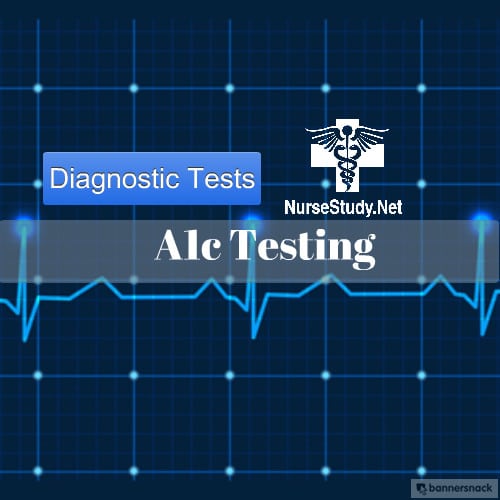Last updated on May 15th, 2022 at 06:12 pm
A1C test review for nurses and nursing students
An A1C test is a blood test that is used to diagnose both type 1 and type 2 diabetes. This exam is also been referred to as a hemoglobin A1C, HbA1c, glycosylated hemoglobin, and glycated hemoglobin.
The A1c results show what your average blood sugar level was for the last 8-12 weeks. A1c exam will measure the percentage of hemoglobin is covered with sugar (glycated). The more elevated the A1c level will indicate the poorer the patients blood sugar control is and puts them at a higher risk for diabetic complications.
Rational for test
The A1c is the primary test utilized to diagnose prediabetes, type 1 diabetes, and type 2 diabetes. After the patient gets a diagnoses of diabetes, this test is used to observe the diabetic treatment plan. This is helpful since it measures the average of the blood sugars for the last 2-3 months instead of the blood sugar at one certain time. It shows the healthcare provider how well the diabetic treatment regime is working. The test is especially helpful when the patient is first learning how to manage their diabetes in the early stages of treatment. It will also assist with establishing a baseline level.
- Type 2 diabetics who do not use insulin and whose blood sugar levels have remained consistent, usually have their A1c level drawn twice a year.
- Type 1 diabetes may have this test drawn 3-4 times per year.
- Type 2 diabetes who are managed with insulin and have blood sugars that are difficult to maintain in currant target range, may have this test drawn at least 4 times per year.
- If diabetic treatment plan is altered, there may be a need for more frequent A1c exams.
This exam is a simple blood draw and is it alright to eat and drink normally before the exam.
Exam Reading
A normal A1c level from 4.5 – 6% usually indicates that the patient does not have diabetes. An A1c level of 8% may indicate that the patient may have had uncontrollable diabetes for a long period of time.
Prediabetes is considered with an A1c of 5.7-6.4%, in this instance the patient may be at risk for developing diabetes.
If the A1c test is above 6.5% on two separate tests, the patient will most likely receive a diagnosis of diabetes.
7% is the common target for patients who have been diagnosed with diabetes. However, these percentages may vary from patient to patient depending on other factors. It is important to remember that A1c normal ranges can vary from hospital to hospital including laboratories.
Inaccurate results
- A1c results may show a false low if the patient is anemic or experiencing heavy bleeding as the hemoglobin stores will be low.
- A1c can be abnormally elevated if there is not enough iron in body.
- If a patient has hemoglobin A, which is uncommon, the A1c may be abnormally high or low.
Below is a table of A1c levels and how it corresponds to blood sugars:
[ws_table id=”15″]
Disclaimer:
The medical information on this site is provided as an information resource only, and is not to be used or relied on for any diagnostic or treatment purposes. This information is not intended to be nursing education and should not be used as a substitute for professional diagnosis and treatment.


